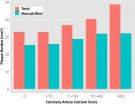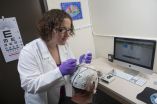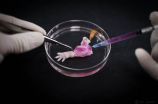Compensatory rehabilitation limits motor recovery after stroke
2015-06-03
(Press-News.org) Washington, DC--Relying on the better-functioning side of the body after a stroke can cause brain changes that hinder rehabilitation of the impaired side, according to an animal study published June 3 in the Journal of Neuroscience. Strokes that occur in one brain hemisphere can result in poor motor function on the opposite side of the body, leading to heavy reliance on the "good" side. This study, led by Soo Young Kim and performed at the University of Texas at Austin and the University of California, Berkeley, found that such compensation produces structural brain changes at the site of the stroke in rats, limiting recovery of the injured side.
Using rats, the researchers selectively damaged an area of the brain that controls the movement of the front legs. Only one side of the brain was damaged, and this led to impairment of the opposite leg.
One group of rats was trained to use the unaffected, "good" leg to compensate for the injury, while the control group did not get this training. Both groups of rats then received rehabilitative training for the injured limb.
The rats that were trained to use their "good" side had less brain area devoted to the control of the impaired limb. They also had more connections between neurons in this area. Rather than being helpful, however, this was linked with worse function of the impaired limb.
"Training the 'good' limb after stroke may ultimately lower the level of improvement that the 'bad' limb can achieve," said Thomas Carmichael, a neuroscientist at the Geffen School of Medicine at UCLA who was not involved in the study. While more research is needed, the study suggests that current neurorehabilitation strategies "may actually be working to reduce the overall level of recovery in stroke patients," he added.
INFORMATION:
The Journal of Neuroscience is published by the Society for Neuroscience, an organization of nearly 40,000 basic scientists and clinicians who study the brain and nervous system. Study author Soo Young Kim can be reached at sooykim@berkeley.edu. More information on stroke can be found on BrainFacts.org.
ELSE PRESS RELEASES FROM THIS DATE:
2015-06-02
OAK BROOK, Ill. -- Non-calcified arterial plaque is associated with diabetes, high systolic blood pressure and elevated 'bad' cholesterol levels in asymptomatic individuals, according to a new study published online in the journal Radiology.
Coronary artery disease (CAD) is the leading cause of death in men and women worldwide, accounting for 17 million deaths annually. Current treatment strategies focus on cardiovascular risk and serum cholesterol levels rather than direct assessment of extent of disease in the coronary arteries.
Plaque that forms in the arterial walls ...
2015-06-02
A new study shows that social and sensory overstimulation drives autistic behaviors. The study, conducted on rats exposed to a known risk factor in humans, supports the unconventional view of the autistic brain as hyper-functional, and offers new hope with therapeutic emphasis on paced and non-surprising environments tailored to the individual's sensitivity.
For decades, autism has been viewed as a form of mental retardation, a brain disease that destroys children's ability to learn, feel and empathize, thus leaving them disconnected from our complex and ever-changing ...
2015-06-02
You might not need to remember those complicated e-mail and bank account passwords for much longer. According to a new study, the way your brain responds to certain words could be used to replace passwords.
In "Brainprint," a newly published study in academic journal Neurocomputing, researchers from Binghamton University observed the brain signals of 45 volunteers as they read a list of 75 acronyms, such as FBI and DVD. They recorded the brain's reaction to each group of letters, focusing on the part of the brain associated with reading and recognizing words, and found ...
2015-06-02
San Antonio -- June 2, 2015 -- A close-up of Comet 67P/Churyumov-Gerasimenko by NASA's ultraviolet instrument surprised scientists by revealing that electrons close to the comet's surface -- not photons from the Sun as had been believed -- cause the rapid breakup of water and carbon dioxide molecules spewing from the surface.
Since last August, the European Space Agency's Rosetta spacecraft has orbited within a hundred miles of the comet in this historic mission. The spectrograph onboard, named Alice, specializes in the far-ultraviolet wavelength band and was developed ...
2015-06-02
Menopausal hormone therapy (MHT) given to recently postmenopausal women in the US for up to four years does not improve cognition, but may have some positive benefits for some mood symptoms, according to a study published by Carey Gleason and colleagues from the University of Wisconsin, Madison, USA, in this week's PLOS Medicine.
The researchers reached these conclusions by conducting a randomized placebo-controlled clinical trial (the KEEPS-Cog trial), including 693 recently postmenopausal women living in the US who were randomly assigned to receive either oral estrogen ...
2015-06-02
What if your doctor told you that your weight is somewhere between 100 and 400 lbs.? With any ordinary scale every patient can do better at home. Yet, one patient can't: the Milky Way. Even though today we peer deeper into space than ever before, our home galaxy's weight is still unknown to about a factor of four. Researchers at Columbia University's Astronomy Department have now developed a new method to give the Milky Way a more precise physical checkup.
The Milky Way consists of roughly 100 billion stars that form a huge stellar disk with a diameter of 100-200 thousand ...
2015-06-02
PHILADELPHIA--(June 2, 2015)--Senescence, a phenomenon in which cells cease to divide and grow, can be caused by everything from natural DNA damage to treatment with chemotherapy. However, several mechanisms allow for cells to bypass senescence and grow out of control, eventually becoming cancerous. Now, scientists at The Wistar Institute have identified how a specific variant of a key protein complex found in human cells called condensin can reorganize a cell's genetic architecture in such a way as to promote senescence, making it an important facilitator in a cell's ...
2015-06-02
A team of Massachusetts General Hospital (MGH) investigators has made the first steps towards development of bioartificial replacement limbs suitable for transplantation. In their report, which has been published online in the journal Biomaterials, the researchers describe using an experimental approach previously used to build bioartificial organs to engineer rat forelimbs with functioning vascular and muscle tissue. They also provided evidence that the same approach could be applied to the limbs of primates
"The composite nature of our limbs makes building a functional ...
2015-06-02
Who says you can't do two things at once and do them both well?
A new University of Florida study challenges the notion that multi-tasking causes one or both activities to suffer. In a study of older adults who completed cognitive tasks while cycling on a stationary bike, UF researchers found that participants' cycling speed improved while multi-tasking with no cost to their cognitive performance.
Results of the study, which was supported by a grant from the National Institute on Aging, were published May 13 in the journal PLOS ONE.
The discovery was a surprise finding ...
2015-06-02
COLUMBUS, Ohio - A new nationwide study reveals that the kind of cities that attract college graduates has changed since the 1990s.
In the 1990s, grads were moving to cities with fast-growing "smart" industries in fields like high tech, the study found. But since 2000, with a less vibrant national economy, college graduates are flocking toward the biggest cities with the biggest labor markets and the best chances of landing a job.
In fact, the effect of city population size in attracting college grads was nearly four times as large in the 2000s as it was in the 1990s, ...
LAST 30 PRESS RELEASES:
[Press-News.org] Compensatory rehabilitation limits motor recovery after stroke


